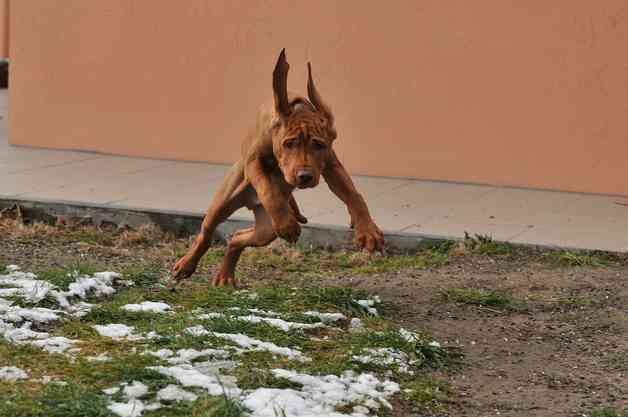The vizsla, also known as the pride of Hungary is no dog for lazy owners, this medium-size hunting dog is very active that’s why crate training a vizsla puppy could be a challenge.
The Vizsla is in the Sporting Group of dogs, they are very active and excel at various sports and activities.
For regular owners, they make excellent jogging or biking companions, but they do need space and do not thrive in apartments unless early training and a lot of outdoor activities are in order.
Vizsla puppies are very intelligent and curious, they can get into trouble if left alone that’s why early and solid communication is of great importance.
What you need to crate train vizsla
Crate training a Vizsla is similar to most dog breeds, the tools you need are the same, what changes are the dog’s temperament, and how long it’s going to take.
You obviously need a crate that fits your dog perfectly and we’ll get back to this point in detail because it’s of great importance, and you also need some treats and toys to use as a lure and rewards.
So let’s see how you can use these three basic tools to crate train a Vizsla puppy efficiently and fast.
The best crate for a vizsla
When choosing a crate for your dog you need to consider two factors, the dog’s size and personality.
Size matters the most because it’s impossible to crate train a dog using a crate that is too small or too big for him.
Too small is understandable because a dog will never feel comfortable in a crate that is too small for him, but most dog owners get confused when we say the crate should not be too large.
Most dog owners feel the need to buy a very large crate the biggest they can put their hands on because they feel bad about crate training their dog and think it’s cruel, but it’s not, dogs are den animals and will feel comfortable in a crate and find a den-like spot anyway.
When the crate is too large for the dog he’ll use one corner as a potty corner and the other as a living area, that’s why all experts advise against this.
Vizslas stand between 21 to 24 inches at the shoulder, the perfect crate for this size should be the following dimensions: 43″L x 28.5″W x 31.5″H, which’s a 42 inches crate.
We strongly recommend a wire crate, one with a divider and two doors is the best for crate training especially at the early steps of crate training.
The one we recommend is the 42″ Midwest Ultima Pro wire crate ( check current price at Amazon), it comes with double doors and a divider so you don’t have to change crates as the puppy grows.
The best training treats and toys for a vizsla

Training treats are a very important tool when it comes to crate training a Vizsla puppy, they can be used as lures when first exploring the crate and also as rewards to enforce good behavior and create that great bond with the crate later on.
We recommend using Zuke’s Mini Naturals Training Dog Treats (check price at Amazon), they come in small bites which is great for controlling the quantity and they’re made of natural ingredients.
As for the toys you’ll need to types, chew toys to keep your Vizsla distracted in his crate, just make sure they’re strongly mad because Vizslas are big chewers, we recommend the Kong chew toy it makes a great food puzzle.
You will also need some interactive toys which are very important in the case of a Vizsla because they’re very active dogs, these toys will help you bond with the dog and level down his energy before he goes into the crate, any set will do we use these ones.
Step 1 Introducing your vizsla to his crate
The first impression is always important in any new relationship and crate training a Vizsla is a new relationship between the dog and the crate.
Introducing your dog to his crate is the first thing to do and you need to make sure it goes smoothly and perfectly.
You can do this simply by starting early in the morning, and by taking things slow, just take your dog with his leash on and circle around the crate.
Dogs are curious pets just let your Vizsla sniff around and get comfortable around it before it’s night time and he has to go in.
Never introduce your dog to something when it’s time to do it, that’s my slogan for crate training dogs.
Step 2 Exploring the crate using treats
Exploring the crate is the next step and you can start once your dog is feeling comfortable around the crate.
At this point, a wire crate is the best option and it makes the whole process a lot easier because it offers a lot of open space and the double door option will make things even easier.
It is at this stage that you need the training treats, you can use them as lures to get the Vizsla into the crate, just make sure you’ve secured the crate’s door to avoid any incidents that may freak out your dog and scare him out of the crate.
Just toss in a treat inside the crate and lure your dog inside, once in you want to reward and praise him heavily to enforce this good behavior.
Keep repeating the same process a few times and your dog will pick up on the vibe and offer to get in the crate on his own to get the treat, and that’s your cue to move on to the next step.
Step 3 Making the crate great
For your dog to accept the crate as his new home, you need to establish a trust and good relationship whit it.
Dogs evaluate places based on their memories and experiences, that’s why the crate should always be associated with great feelings only.
The best way to start is food, dogs love food and it’s a great tool to make the crate great, you can start serving the dog’s meals in the crate.
At first, you want to keep the crate open, just let your dog get his meal and get out freely, and while distracted you can partially close the door keeping an eye on his reaction.
Step 4 Spending time in the crate closed
It is best to stay next to your dog while in the crate so he feels secure, and if he shows no objections to being in there you can close the door.
Try to increase the time your Vizsla spends in the crate closed after the meals, and that’s when the toys come in handy.
The kong is very important at this stage it makes a great food puzzle that will keep your dog distracted for a long time.
Before it’s time to go into the crate make sure your Vizsla gets enough playtime, interactive toys will serve you best.
Vizslas are very active dogs and a crate is a place where the dog is supposed to relax and lay down, so if he’s still full of energy you’ll have a hard time making him stay in it.
Gradually increase the time your dog spends in the crate after his meals and slowly move away from the crate for a few minutes every time while keeping an eye on your dog’s reaction.
Once your dog is spending 30 minutes alone in the crate and he’s not whining in there you know you can move on to the last and final step.
Step 5 Home alone
Now that your Vizsla is spending time alone in the crate closed with you away from the room, you can proceed to the final step, leaving your dog home alone.
Before you do that there are is something you need to be aware of, you should avoid making a scene out of leaving and coming back.
You want to stop interacting with your dog at least five minutes before you leave, if you make a scene and say goodbye your dog will associate the crate with being left alone and will reject it eventually.
The same thing goes for coming back home, give it a few minutes before you let your dog out of the crate this way he knows that being in the crate does not always mean you’re leaving.
At first, start with short periods of 30 minutes, Vizslas don’t like to be left alone at all, leave your dog distracted with a kong or another toy when leaving.
Making sure your dog has plenty of playtime before going into the crate is your key to crate training a Vizsla perfectly.
Crate training a vizsla puppy at night

Crate training a Vizsla at night especially the first night requires a lot of patience and attention, that’s why it is best to start early in the morning to give your dog enough time to adjust.
Most dogs will whine in the crate at night for the first few nights, some more than others, what you should know is that you can’t let your dog out no matter what.
Letting the dog out of the crate while barking is letting him know that barking and whining is the out and he’ll keep doing it, so you just have to ignore it, and no it’s not cruel.
If your puppy does not stop barking and whining after five minutes just talk to him or tap gently on the crate to stop his whining cycle.
We found that it is best to place the crate in the same room you’re sleeping in at least for the first few nights, this way you can calm your dog when he wakes up.
Make sure your dog is tired before he goes in for the night, the less energy the dog’s got left the less likely he’s to bark or complain.
Also, you need if crate training a young puppy to stop watering him at least two hours before he goes in and take him for his business just before he has to sleep.
Young puppies have small bladders and will probably not hold it for a full night that’s why you want the crate close to you so you can hear him when he wakes up for a potty break.
Dogs are fairly clean pets and would not pee where they sleep so he’ll try and hold it but you need to let him out, in case he does pee in the crate you can read this article about how to deal with it.
When you take the dog out for a break it needs to be all about peeing and nothing else, it’s not playtime.






